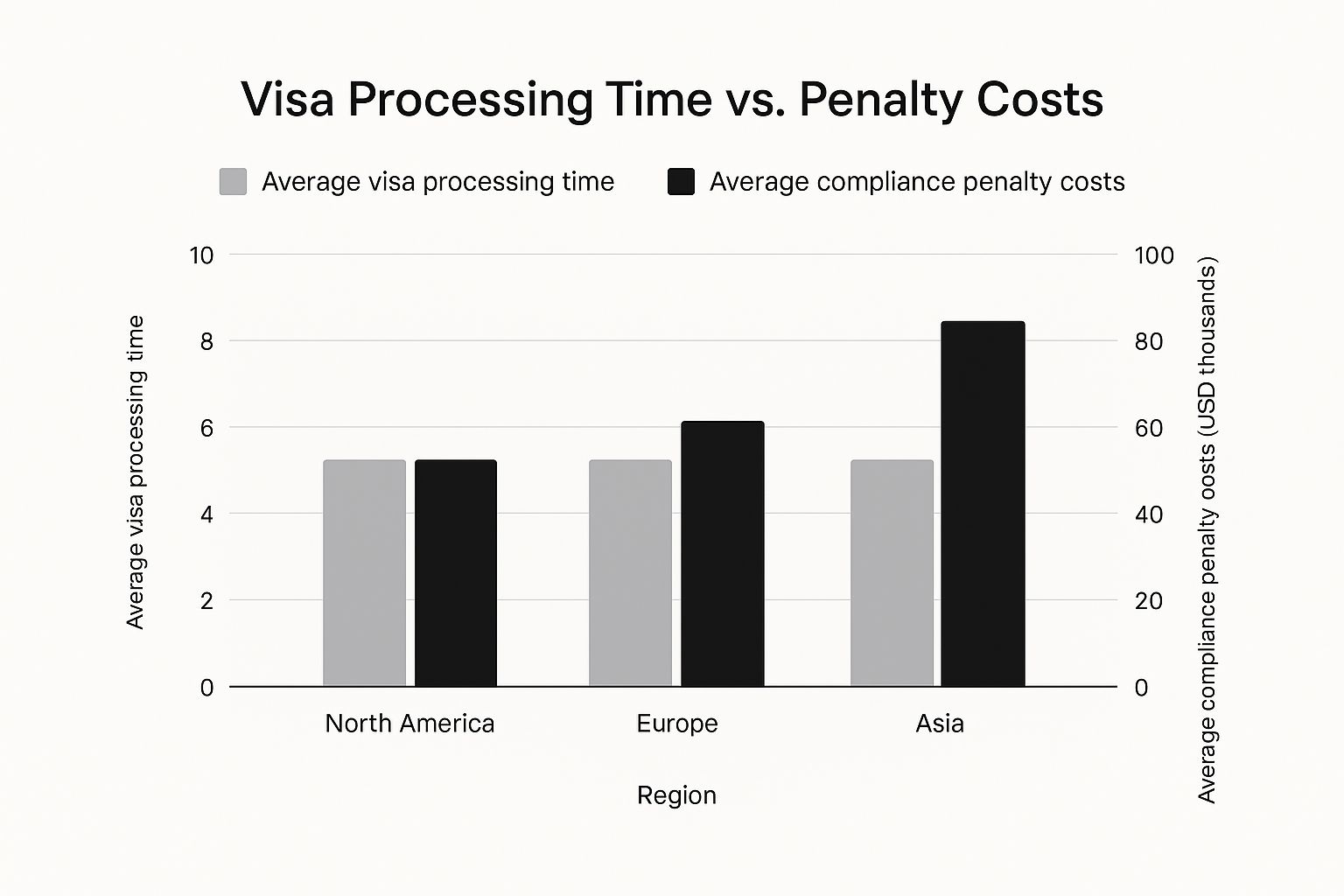Let’s be honest: the idea of your entire team sitting within a few square miles of your office is quickly becoming a relic of the past. Today, smart businesses are thinking bigger. They’re casting a much wider net for talent, a shift supercharged by the rise of remote work and the relentless need for a competitive edge.
An international employee is simply someone who works for your company but lives in a different country, whether they’re fully remote or have relocated. Think of it less as hiring abroad and more as shifting from a local talent pond to a global talent ocean. It’s about tapping into a world of specialized skills to build a more diverse, powerhouse team.
Why Global Teams Are Becoming the New Standard

This isn’t just a fleeting trend. It’s a fundamental change in how modern, forward-thinking companies operate and scale. Hiring international employees is no longer a perk reserved for massive corporations; it’s a core strategy for growth and innovation for businesses of all sizes.
The main driver behind this shift is simple: access to a ridiculously expanded talent pool. Sticking to local hiring is like fishing in a small pond—you’re limited to whatever happens to swim by. Going global turns that pond into an ocean, teeming with unique skills, experiences, and perspectives you’d never find in your own backyard.
Tapping into a World of Expertise
Imagine you need an engineer who’s an expert in a super-niche area of AI, or maybe a customer support specialist fluent in a rare dialect. Your local market might come up empty. But when you look globally, you can find the perfect person for the job, no matter where they live. This is make-or-break for companies that want to lead their industry, not just follow it.
This worldwide talent search is fueled by a few key advantages:
- Specialized Skill Sets: You can finally hire those experts in tech, engineering, or creative fields that are impossible to find locally.
- Diverse Perspectives: Building teams with different cultural backgrounds is proven to spark more creative problem-solving. A team that looks like your global customer base is naturally better at understanding and serving it.
- Operational Efficiency: You can create a “follow-the-sun” model where work gets done around the clock. This means faster project turnarounds and the ability to offer genuine 24/7 customer support.
A Strategic Imperative for Growth
Hiring internationally is more than just filling empty seats. It’s a strategic move that builds a more resilient and adaptable company. A geographically distributed workforce is far less vulnerable to local economic slumps or talent shortages.
By embracing a global workforce, companies are not just hiring individuals; they are investing in a dynamic, resilient, and innovative future. Mastering the art of managing international employees is now a critical skill for any leader focused on sustainable growth.
Of course, this new standard requires a fresh playbook for management, communication, and company culture. Successfully leading a global team means navigating complex legal rules, bridging cultural gaps, and creating a unified team spirit across continents and time zones. In the sections ahead, we’ll dive into how to tackle these challenges and truly unlock the massive potential of your global team.
The Strategic Advantages of Hiring Globally

Let’s move past the theory. Hiring international employees brings some powerful, real-world benefits that can completely change a company’s path forward. This isn’t just an HR project; it’s a core business strategy that builds a more resilient company, seriously upgrades your service, and fuels long-term growth.
When you start looking beyond your own borders, you unlock a set of advantages that a purely local team just can’t match.
One of the first things you’ll notice is a huge jump in innovation. It’s only natural—a team of people from similar backgrounds, no matter how talented, will often tackle problems from the same angle. Bringing international employees into the mix completely shatters that echo chamber.
Think of it like a potluck. If everyone brings potato salad, the meal gets pretty boring, fast. But when people bring dishes from their own unique backgrounds, you get a rich, varied, and much more exciting feast. A global team works the same way, solving tough problems with a creative spark that comes from different life experiences and new ways of thinking.
Gaining a 24-Hour Operational Advantage
Here’s another game-changer: the “follow-the-sun” model. When you have team members strategically located across different time zones, your business can literally operate around the clock. This creates a continuous cycle of productivity that speeds everything up and radically improves customer service.
Imagine a software company where the team in Europe hands off their work to a team in North America at the end of their day. That team then passes it to colleagues in Asia. The project keeps moving forward 24 hours a day, slashing development timelines.
This also means you can offer true 24/7 customer support without forcing anyone to work grueling night shifts. Your customers get the help they need, when they need it, which is a massive boost for satisfaction and loyalty. Of course, this requires sharp coordination, and understanding things like global leave policies is key. For a deeper dive, check out our guide on employee absence management.
Optimizing Costs While Accessing Premier Talent
Hiring internationally also comes with a significant financial upside. By recruiting in different economic zones, companies can optimize their operational costs without ever compromising on quality. It gives you access to top-tier talent in places where the cost of living—and salary expectations—might be lower than in major hubs like Silicon Valley or London.
But this isn’t about finding the “cheapest” labor. It’s about getting the best value by tapping into highly skilled and educated workforces in emerging markets. This smart approach to resourcing lets you build a stronger team than your budget might otherwise allow.
By strategically hiring across the globe, a business can achieve a dual victory: lowering operational overhead while simultaneously raising its overall talent ceiling. This approach transforms the hiring process from a cost center into a strategic investment in global excellence.
The positive impact shows up in the workforce, too. Recent data reveals a clear upward trend in worker engagement on global teams. The share of fully engaged international employees worldwide just hit 19%—a record high over the last decade and a big jump from the pandemic low of 14%. You can explore the full report on global workforce engagement from adpresearch.com to see the trends for yourself.
This rising engagement proves that with the right support and an inclusive culture, a distributed team can be more motivated and connected than ever. When you add it all up, the benefits are clear: hiring internationally is a strategic must for any company that wants to compete and win on a global stage.
Solving the Core Challenges of a Global Team
Going global opens up a world of talent and opportunity, but let’s be honest—it also brings its own unique flavor of headaches. These obstacles are very real, but they are absolutely solvable with the right game plan. Getting it right means tackling the messy realities of international employment head-on, from baffling legal codes to bridging cultural divides.
One of the first brick walls companies run into is the sheer complexity of hiring across borders. You have to navigate a dense jungle of local laws, and a solid international employment law guide is non-negotiable. Every country has its own playbook for labor laws, tax codes, and payroll rules. One wrong move in one country can trigger a cascade of legal problems and hefty fines.
This is where the dream of a global team can quickly turn into a compliance nightmare. You can’t just copy-paste your domestic HR policies and expect them to work. Everything from mandatory holidays and benefits to how you can let someone go is different.
Navigating Legal And Compliance Hurdles
So, how do you cut through this red tape without getting tangled up? The smartest move is often to partner with an Employer of Record (EOR).
Think of an EOR as your expert on the ground. They handle all the legal and administrative grunt work, becoming the legal employer for your international staff and guaranteeing you stay on the right side of local laws.
This lets you bring on the best people anywhere on the planet without having to set up a whole new legal entity in their country. An EOR takes care of:
- Compliant Payroll: Making sure taxes and social security are handled perfectly.
- Benefits Administration: Crafting benefits packages that are both competitive and legally sound.
- Labor Law Adherence: Managing employment contracts and practices by the local book.
Essentially, an EOR outsources the risk, which frees you up to focus on what actually matters: welcoming your new team members and growing the business. It turns a legal maze into a straightforward path forward.
Bridging Cultural And Communication Gaps
Once you have the legal side sorted, you’ve got to deal with the human side of things. This can be just as tricky. What’s considered direct and honest feedback in one culture might feel rude and aggressive in another. Norms around work-life balance and communication styles are all over the map.
Building an inclusive culture where everyone feels seen and heard is the key. It all starts with awareness and a bit of education. Encourage your team to get curious about each other’s backgrounds and ways of communicating. For managers, this means being flexible and ditching a one-size-fits-all leadership style.
Creating a truly inclusive global culture isn’t about erasing differences; it’s about building a framework of shared values and communication protocols that allows those differences to become a source of strength and innovation.
To put this into practice, set up some clear communication ground rules. For instance, you might decide on English for company-wide updates but lean on translation tools for team chats to make sure nothing gets lost. Define your expectations for response times to account for time zones and prevent people from burning out.

As the data shows, some regions come with more administrative hurdles and higher compliance risks than others. This just highlights why having that local expertise is so critical.
Overcoming Logistical Roadblocks
Finally, you’ve got the pure logistics of running a team scattered across the globe. Juggling time zones, figuring out fair pay in different economies, and making sure everyone has the tools they need are all part of the package. If you don’t nail the logistics, it’s easy to create a divide where some employees feel like second-class citizens.
Here are a few practical strategies to get you started:
- Time Zone Management: Schedule meetings in a tight window that’s reasonable for everyone. For everything else, rely on asynchronous tools like project boards and shared documents. Work shouldn’t grind to a halt because someone’s asleep.
- Fair Compensation: Base your pay on local market rates and cost of living. This ensures you’re offering competitive salaries that are fair to everyone, no matter where they call home.
- Equitable Resources: Make sure every single employee has access to the same quality of tech, software, and training opportunities. This is crucial for avoiding an “us vs. them” culture between headquarters and the rest of the team. Giving everyone the right tools and skills also makes it easier to cross-train employees, building a more resilient and versatile workforce.
Managing an international team is a constant balancing act. To help you stay on top of it, we’ve summarized the most common hurdles and their solutions.
Common Challenges and Strategic Solutions for Managing International Employees
Here’s a quick-glance table breaking down the typical issues that pop up when you hire globally, along with practical ways to tackle them.
| Challenge | Potential Impact | Strategic Solution |
|---|---|---|
| Legal & Compliance | Fines, legal action, hiring delays, reputational damage. | Partner with an Employer of Record (EOR) to handle local payroll, taxes, benefits, and labor law compliance. |
| Cultural Differences | Miscommunication, team friction, decreased morale, lower productivity. | Invest in cross-cultural training. Establish clear communication guidelines and promote an inclusive, open culture. |
| Communication Gaps | Misunderstandings, project delays, feelings of isolation among remote staff. | Use a mix of synchronous and asynchronous communication tools. Set clear expectations for response times across time zones. |
| Time Zone Juggling | Burnout, meeting fatigue, difficulty in real-time collaboration. | Limit mandatory meeting times to a core collaboration window. Heavily rely on shared documents and project management software. |
| Fair Compensation | High turnover, difficulty attracting top talent, perceived inequity within the team. | Implement a localized compensation strategy based on market rates and cost of living for each employee’s region. |
| Equitable Resources | A “headquarters vs. remote” divide, inconsistent performance, employee frustration. | Standardize equipment and software access. Ensure equal opportunities for professional development for all team members. |
Navigating these challenges isn’t just about avoiding problems; it’s about building a stronger, more dynamic, and truly global organization. By anticipating these issues and having a clear strategy, you set your team up for success from day one.
Your Playbook for Hiring and Onboarding Talent
Getting international hiring right starts long before your new team member’s first day. A truly world-class experience isn’t an accident; it’s a deliberate, step-by-step approach that balances global consistency with local flexibility. It’s all about creating a welcome that makes new hires feel valued and connected right from the start.
This all begins with how you present the role to the world. Think of your job description as the first handshake—it needs to speak a universal language.
Crafting Inclusive Job Descriptions
If you want to attract a truly global talent pool, your job descriptions have to be free of culturally specific jargon, idioms, or requirements that might accidentally shut the door on great candidates. The focus should always be on core competencies and skills, not on credentials that only make sense in one country.
Here are a few simple but powerful adjustments to make:
- Use Gender-Neutral Language: Swap out terms like “salesman” or “right-hand man” for inclusive titles and descriptions. It’s a small change with a big impact.
- Explain Your Culture: If you toss around a phrase like “work hard, play hard,” take a moment to explain what that actually means at your company. This avoids a ton of misinterpretation.
- Be Crystal Clear About Remote Work: Let people know upfront if a role is fully remote or if it requires availability during certain core hours. Managing time zone expectations early saves headaches for everyone.
Once your job description is ready to go, you need to know where to find the right people. Your usual local job boards just won’t cut it. It’s time to cast a wider net.
Sourcing Talent Across Borders
Finding top international talent means going where they are. This isn’t just about posting on a few more websites; it’s about diversifying your channels to include global job platforms, professional networks, and communities specific to certain regions.
It also pays to understand what’s happening in the global talent market. The global unemployment rate recently hovered at a relatively low 4.9%, but that number doesn’t tell the whole story. Some countries are seeing unemployment drop while it rises in others, creating a patchwork of opportunities for savvy recruiters. Knowing these nuances helps you target your search far more effectively. You can dig deeper into these global employment trends from the World Economic Forum.
With your candidate selected, the spotlight shifts to making their transition into the company as smooth as possible. A well-designed onboarding process is the foundation for their long-term success.
Designing a World-Class Onboarding Experience
Let’s be honest: onboarding international employees is an art. The real goal is to make someone feel like part of the team, even if they’re thousands of miles away. You have to blend structured processes with genuine human connection.
A successful global onboarding program really needs to nail a few key things:
- Tech and Tools Setup: Don’t wait until the last minute. Ship all the necessary equipment well before their start date. And please, provide clear, step-by-step instructions for setting up accounts and getting into key systems like Jira or HubSpot. Making sure these tools work together is critical for collaboration, and a smooth HubSpot-Jira integration can make a world of difference.
- Virtual Team Introductions: Get those introductory video calls on the calendar with their immediate team and other key people they’ll be working with. Assigning an onboarding “buddy” is also a great move—it gives them a friendly, informal person to ask all the “silly” questions.
- Cultural and Values Immersion: A handbook is fine, but it’s not enough. Organize sessions to actually discuss the company’s mission, values, and communication style. Use real-world examples to show how those values show up in day-to-day work.
- Clear Expectations and Goals: Nobody should have to guess what’s expected of them. A clear 30-60-90 day plan is your best friend here. It should outline specific responsibilities, initial projects, and performance goals to give your new hire a roadmap for success from day one.
A great onboarding experience closes the distance between a new hire and the company. It’s the moment where a global recruitment strategy transforms into a tangible, personal connection, laying the groundwork for engagement and loyalty.
Finally, you have to get the practical stuff right, and that means payments. As you build your global team, figuring out the best ways to pay international contractors is non-negotiable for ensuring everything is timely, compliant, and efficient. By mapping out each of these steps, you can build a hiring and onboarding playbook that doesn’t just attract top global talent—it sets them up to truly thrive.
How to Foster Connection and Clear Communication

When you’re running a global team, communication is everything. It’s the glue holding your entire operation together. Get it wrong, and you end up with silos, misunderstandings, and a general disconnect that slowly chips away at collaboration.
The goal is to build bridges—making sure every single international employee feels seen, heard, and plugged into the company’s bigger picture.
That journey usually starts by setting a common company language, which for many is English. But that’s just the first step. True inclusion means giving people the right tools to contribute fully, no matter what their native language is.
Using Technology as a Bridge
This is where modern tech really shines. Think of AI-powered tools less like a crutch and more like a universal translator that gives everyone on your team a voice.
AI platforms can offer real-time translation and transcription, dissolving language barriers in meetings and written chats almost instantly. This is a massive confidence booster for non-native speakers, allowing them to follow complex discussions and jump in with their own ideas. For customer-facing teams, it’s an absolute game-changer. Just look at these use cases for a multilingual service desk to see how AI is already helping deliver incredible global support.
Here’s what that looks like in practice:
- Real-Time Meeting Transcription: Team members can follow along in their own language, making sure they don’t miss a single detail.
- Instant Chat Translation: Conversations in tools like Slack or Microsoft Teams just flow, without awkward pauses for translation.
- Accessible Documentation: Company policies, project briefs, and key documents become instantly available to everyone.
When you embed language tech into your daily workflow, you take the pressure off the individual. The system handles the translation. This one change creates a fairer, more inclusive space where the best ideas can surface from anywhere.
But technology is only part of the puzzle. The other part is mastering the unique communication style of a distributed team.
Mastering Asynchronous and Cross-Cultural Communication
When your team is scattered across different time zones, asynchronous communication—where you don’t expect an instant reply—becomes the norm. This demands clarity, precision, and a healthy dose of empathy.
Effective asynchronous work means writing detailed project updates in your project management tools or recording quick video walkthroughs. It’s all about giving your colleague on the other side of the planet enough context to pick up where you left off without needing a live call.
Cultural nuances are just as critical. A direct, to-the-point email might be perfectly normal in one culture but come across as blunt or even rude in another. Even small things like emojis, humor, and capitalization can be interpreted in wildly different ways. To really nail this, it’s worth exploring strategies for mastering cross-cultural communication and building genuine understanding.
Finally, make your virtual meetings intentionally inclusive. Send out agendas ahead of time, rotate meeting times to be fair to different time zones, and create a habit of pausing to ask quieter team members for their thoughts. These small tweaks make a huge difference. They ensure your international employees aren’t just showing up; they’re actively contributing and feel valued. Combine smart tech with thoughtful communication habits, and you’ll build a global team that’s truly connected.
The Future of Global Talent and Your Business
The world of work isn’t just changing; it’s being rewired in real time. For any business with growth ambitions, the race for top talent is no longer local—it’s gone global. This shift creates a playing field buzzing with both incredible opportunities and brand-new challenges. The future belongs to those who can adapt, learn, and steer their talent strategy on a worldwide scale.
Digital transformation is the engine behind most of this upheaval, constantly reshaping jobs and the skills needed to do them well. This isn’t a slow crawl; it’s a massive leap. The World Economic Forum projects that major economic and tech changes are driving a net increase of 7% in jobs worldwide. That’s not a small number—it translates to roughly 78 million new positions opening up in the next few years. You can dive deeper into these shifts in this global hiring trends report.
This growth screams one critical reality: the skills your business leans on today might be completely different from what you’ll need tomorrow. Future-proofing your workforce isn’t something you do once; it’s an active, ongoing cycle of upskilling and smart hiring.
The Skills That Will Define Tomorrow
As technology gets better at handling routine tasks, the demand for uniquely human skills is skyrocketing. These are the abilities that machines struggle to copy, and they’re becoming the most valuable assets you can have in a global workforce. The competencies most in-demand include:
- Analytical and Creative Thinking: The power to dissect complex problems and dream up original, effective solutions will be non-negotiable.
- Technological Literacy: A solid grasp of AI, big data, and other digital tools is shifting from a niche skill to a core requirement for almost everyone.
- Emotional Intelligence and Resilience: In a world of distributed teams, the ability to collaborate, show empathy, and roll with constant change is what separates good teams from great ones.
Embracing agility, promoting continuous learning, and adopting a proactive approach to global talent management are no longer optional. They are the essential pillars for any business aiming to thrive in the complex, ever-evolving landscape of international employment.
Building an Agile and Future-Ready Workforce
So, what does this all mean for your strategy? It means you need to build a talent model that’s all about flexibility and continuous growth. To attract and keep the best international employees, you need to show a real commitment to their development and have the infrastructure to support a team scattered across the globe.
This kind of forward-thinking approach demands careful planning and resource management. Knowing your team’s capabilities and making sure you have the right people in the right roles is absolutely fundamental. For a practical guide on getting this right, check out our article on effective staff capacity planning.
At the end of the day, success will be defined by how well organizations can weave talent from all corners of the world into a single, innovative, and resilient team. The companies that figure this out won’t just survive what’s coming—they’ll lead the charge.
Got Questions About Your International Team? We Have Answers.
Going global with your talent pool is exciting, but it definitely brings up a lot of new questions. When companies start hiring across borders, it’s common for managers and HR leaders to run into the same hurdles. Let’s clear up some of the most common ones with straightforward answers.
What’s the Biggest Legal Landmine When Hiring Abroad?
The single most common—and expensive—mistake is getting classification wrong. It’s tempting to label an international hire as an independent contractor to sidestep complex local labor laws, taxes, and mandatory benefits. But honestly, it’s a high-stakes gamble that rarely pays off.
Getting this wrong can unleash a storm of penalties. We’re talking steep fines, years of back taxes, and painful legal battles. The most reliable way to sidestep this minefield is to partner with an Employer of Record (EOR). Think of an EOR as your in-country legal expert; they act as the official employer in the host country, making sure you’re 100% compliant with all local rules and shielding your business from risk.
How Do You Actually Build a Strong Culture When Everyone’s Remote?
Creating a real sense of team unity across different countries and time zones takes work. You can’t just hope it happens on its own; you have to be intentional about building it, day in and day out.
A strong global culture isn’t about forcing everyone to be the same. It’s about creating a shared purpose and a feeling of belonging that actually celebrates different perspectives and makes the distance feel smaller.
Here are a few strategies that genuinely make a difference:
- Be a Broken Record About Your Values: Define your company’s core values and then talk about them all the time. Show how they connect to real work and everyday decisions, not just posters on a wall.
- Create a Virtual Water Cooler: Set up dedicated channels for the fun, non-work stuff. Virtual coffee breaks, channels for pet photos, or groups for shared hobbies help people build the personal connections that glue a team together.
- Shout Out Wins from the Rooftops: When someone does great work, make sure the whole company hears about it. Celebrating successes publicly helps everyone, no matter where they are, feel like a vital part of the team’s wins.
- Invest in Face Time: When it’s feasible, getting people together in person, even just occasionally, is incredibly powerful. These meetups can forge bonds and reinforce that shared identity in a way that screens just can’t.
What Are the Best Tools for Paying People in Different Countries?
International payroll is a beast. You’re juggling different currencies, confusing tax withholding rules, and a unique set of compliance headaches for every single country.
Your best bet is to go with a specialized global payroll platform or lean on an EOR service that handles all of it. These services automate the tricky stuff like currency conversions, manage all the tax deductions, and guarantee you’re compliant with local financial laws. By using a dedicated service, you get rid of the administrative nightmare and the huge risk that comes with trying to manage it all yourself. It’s the best way to make sure your international team gets paid accurately and on time, every single time.
When your team is global, you can’t let language be a barrier. resolution Reichert Network Solutions GmbH makes it simple with Issue Translation for JSM, an AI-powered app that delivers instant, on-the-fly translation right inside Jira Service Management. Let your agents support customers in any language, boosting satisfaction and closing tickets faster. Try Issue Translation for JSM free on the Atlassian Marketplace and start delivering seamless global support today.
